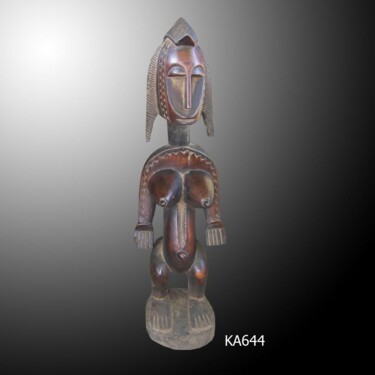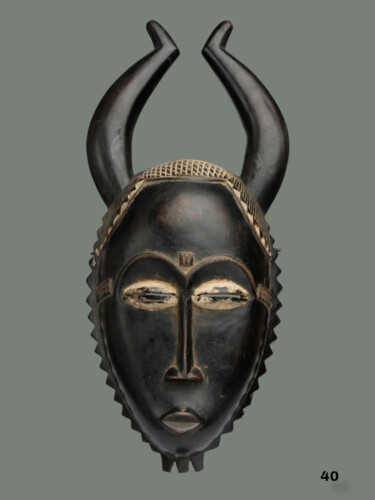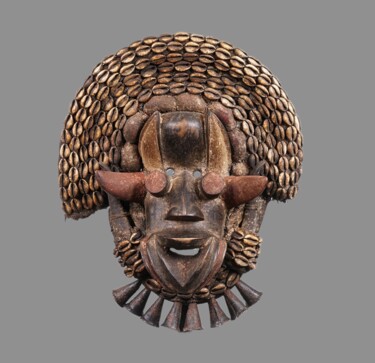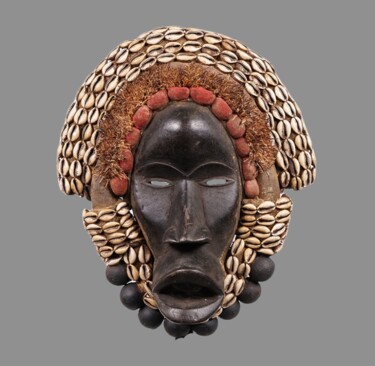139 販売のためのオリジナルの現代彫刻:
{スタイル}スタイルを定義する方法は?
先住民族の視覚芸術と物質文化は部族芸術と呼ばれ、非西洋芸術、民族誌芸術、またはより物議を醸す原始芸術として知られることもあります。部族芸術は通常、儀式的または精神的な機能を持っています。典型的には農村部の始まりを持つ部族文化からのオブジェクトのデザインと職人技は、部族芸術と呼ばれます.
19世紀、西洋の著名な芸術家たちは、西洋以外の芸術を芸術とは考えていませんでした。代わりに、これらのオブジェクトは、「エキゾチックな」または「原始的な」社会の遺物や例と見なされていました。しかし、20 世紀後半になると、部族芸術に対する態度が変わりました。 1960 年代にポストモダニズムが出現する前は、美術評論家は部族芸術を主に形式主義的な観点から見ており、象徴的な意味、歴史的または文化的文脈、作品の芸術家の意図をほとんど考慮していませんでした。それ以来、西洋のコレクションに含まれるアフリカン アートなどのトライバル アートは、国際的なコレクター、展覧会、アート マーケットから高く評価されるようになりました。
「トライバル」というフレーズは、原始主義に関連するあまり洗練されていない種類の芸術を意味する可能性があり、スキル、デザイン、意図、または概念の欠如を示唆しています.しかし、部族芸術は単純で原始的なものではなく、私たちの期待をはるかに超える実行スキルを頻繁に持っているという現実を認識して、博物館が所蔵品を再調査し、再収集するにつれて、それはますます一般の関心を集めています.さらに、それは私たちの魂に届く力を持っています。私たちの内なる本能が目覚め、説得力のある存在と感情的なエネルギーの結果として、私たちは彼らの真実とつながり、精神的な深さの認識を高めます.
歴史的に、西洋の人類学者、個人の収集家、民族誌や自然史の博物館は、部族の芸術作品を収集してきました。博物館のコレクションでは、部族芸術は 3 つの主要なカテゴリに分類できます。アメリカ大陸とオセアニアの芸術、特にオーストラリア、メラネシア、ニュージーランド、ポリネシアの芸術です。アフリカの芸術、特にサハラ以南のアフリカの芸術。
アフリカの部族芸術
石の彫刻、木彫り(マスクと彫刻)、ジュエリー、かご細工、テキスタイル、パイプ、楽器、武器、ビーズ細工、ドアや壁の装飾などの建築的特徴のデザインはすべて、アフリカの部族芸術の例です。これらの工芸品の開発は、ツール、リソース、およびノウハウへのアクセシビリティによって影響を受けました。すべての部族がこれらの芸術的努力に従事しているわけではありません。最も典型的な素材は木で、しばしば粘土、絵の具、貝殻、ビーズ、象牙、金属、羽毛、動物の毛、ラフィアで装飾され、まれに半貴石でさえ飾られました.
アフリカの芸術は、包括的な宗教の基本的な部分でした。すべての生物に存在するとされる生命力は、それらの具体化または代表として機能する特定の画像によって表されました。部族の祖先の本質は、これらの死者の表現によって保存され、彼らは頻繁に彼らのために話し、人々に先祖の霊とつながる機会を与えました.アフリカの部族の工芸品は、通常、特定の儀式や儀式の用途のために宗教芸術として作成されましたが、使用される形式の多くには世俗的な要素が含まれており、一部の芸術作品は純粋に装飾的で装飾的です.
若い男性や老人の「社会」など、それぞれ独自のシンボルとカルトのモチーフを持つ年齢グループへの入会は、多くの部族の儀式の基礎となっています。そのような「社会」は、彫像や仮面が豊富にあることで知られており、その多くは雷神や火神のような守護神を表しています。彫刻は、一部の社会によって高級品としてほとんど独占的に製造されていましたが、マスクと同じくらい遍在し、人気があり、儀式的な意味を持っていました.ナイジェリアのヨルバ族は熟練した丸い形の彫刻家であり、非常に生き生きとした人形の大群で典型的な大きなマスクを頻繁に戴冠させ、パーティーが進行中であるかのような錯覚を引き起こしました.彫刻家は、他の部族、特にヨルバ族の間でのアフリカの彫刻の優れた能力と評判のために、西側の有名な芸術家に似た身長と悪評を達成することができました.
オセアニック トライバル アート
オセアニア準地域は、ポリネシア、ミクロネシア、メラネシア、オーストラリアの 4 つの民族地理学的地域で構成されています。オセアニアの部族芸術とは、これら 4 つの地域に住む先住民族の文化的伝統と創造的な歴史を指します。このラピタ文化は、最終的にポリネシア、ミクロネシア、メラネシアの大部分に影響を与えました。もう 1 つの要因は、ベトナムのドンソン文明でした。この文明は西暦 600 年頃から栄え、西太平洋の重要な交易業者でした。この文明の青銅器の遺物は、オセアニア全体で発見されています。
各地域や島のグループには独自の美的伝統があり、芸術や工芸品を形作っていましたが、海の部族芸術は、超自然、精神崇拝、豊饒を含む異教の出来事に関連していました.ボディー ペインティング、タトゥー、絵画、彫刻、木彫り、テキスタイル アートなど、多種多様な芸術形式が生み出されましたが、アーティストや職人が使用する素材の大部分は腐りやすいものでした。その結果、石造りの建物や彫刻を除いて、少数の例しか残っていません。
ラパ・ヌイ/イースター島とマルケサス島の記念碑的な石の彫刻 (モアイ) は、ポリネシアの多くの東部および遠隔地に共通する、突き出た舌と膨らんだ目を持つ擬人化された人物を組み込んだデザインの使用を例示しており、ポリネシア芸術の有名な例の 1 つです。生き残ったもの。他の例には、西ポリネシアの高度に装飾された樹皮の布が含まれます。
仮面はメラネシア全体で複雑な異教の儀式やカルトの実践で使用されていたため、仮面は先住民族の芸術の重要なモチーフでした.ミクロネシアの部族の遺物には、ボディ ペインティングや入れ墨に加えて、彫刻が施された木製のボウル、塗装されたボート、様式化された木製のマスクも含まれます。ボディ ペインティング、ロック ペインティング、樹皮のペインティング、岩の彫刻、立っている石、彫刻、彫刻、道具や武器の装飾装飾は、オーストラリアのアボリジニ アートで使用されている数多くのスタイルとメディアのほんの一例です。
アメリカの部族芸術
アメリカ・インディアンの芸術は、前者の遊牧的でハンタースタイルのライフスタイルと、後者の少し静的であるにもかかわらず貧しい環境の両方から大きな影響を受けてきました.地域ごとに異なる創造的な伝統の出現におけるもう 1 つの重要な側面は、木材、枝編み細工品、金属、動物の骨、粘土、綿などの資源へのアクセスのしやすさでした。
南西部の部族は、織物、陶器、フレスコ画の専門家でした。これらの部族には、ズニ族、ナバホ族、ホピ族、アリゾナ南部のホホカム族、アリゾナ北部とニューメキシコ州のアンサジ族、ニューメキシコ南西部のミンブレス族、アンサジ族が含まれていました。南西部のネイティブ アメリカンは、しばしばドライ ペインティングとして知られるサンドペインティングを発明しました (特にナバホ族)。
中西部では、部族が文化の形成に単独で責任を負っていました。これらの部族は、複雑な織物芸術と、さまざまな動物に似せて造られた有名な土塁、または「彫像マウンド」で知られていました。部族芸術には、彫刻が施された木製のボウルと磨かれた石と銅の装飾品に加えて、非常に現実的なものから抽象的なものまでのパターンを持つ彫刻された石のパイプも含まれていました。
南東部地域では、鳥や動物の形をしたパイプ、細かく彫刻された貝殻、精巧に塗装された衣料品も生産されました。劣悪な粘土を使用しているにもかかわらず、精巧な陶器を生産することで有名でした。陶器の作品は、儀式、宗教、および私的な使用のために、さまざまな花柄や幾何学模様で作成および装飾されました.
ネイティブ アメリカンのかご細工は、西海岸、特にカリフォルニアで著名な芸術でした。特に、北東部インディアンのイロコイ族は、織られたワンパム ベルト、ヤマアラシのクイル細工、False Face Society のマスクで知られていました。北西部で生み出された最高の部族芸術は彫刻、特に木彫りでした。手彫り彫刻の最も人気のあるスタイルの 1 つは、トーテム、小さな木製の置物、および石やアワビの貝殻で頻繁に象嵌され、丹念に塗装された仮面でした。
部族芸術が現代美術に与えた影響
19世紀半ばまでに、より多くの遠征が部族の遺物を持ち帰るにつれて、当時プリミティビズム/原始芸術として知られていたもの、典型的には黒人アフリカの芸術への関心が高まり始めました. 19 世紀後半から 20 世紀初頭にかけての重要な部族美術展も、非西洋美術を西洋美術コミュニティに公開しました。 1941 年のアメリカン インディアン アートや 1935 年のアフリカン ネグロ アートなどの重要な展覧会が近代美術館で開催されました。
芸術家たちは、部族の神々や儀式用の仮面の彫像で、西洋美術に代わるモデルを発見しました。その非自然主義的で高度に様式化された形には、強力で非常に感情的なイメージも組み込まれていました。部族芸術は、ヴィンセント・ヴァン・ゴッホやアンリ・マティス、ポール・ゴーギャン、パブロ・ピカソなどの有名な芸術家に大きな影響を与えました。最も印象的な初期の効果はキュービズムであり、絵を断片化し、遠近法を放棄することにより、部族芸術の形式的な意味を主に利用することにより、西洋のパラダイムを急速に弱体化させました.抽象芸術は、この主な成果の 1 つです。
ドイツのグループ、Die Brücke は、同時期に非西洋美術の原始的、本能的、儀式的な要素により焦点を当て始め、表現主義として知られる主要な現代美術運動を確立しました。ダダイストは、チューリッヒ、ニューヨーク、そして最後にパリの部族芸術、キュービズム、表現主義からインスピレーションを得て、西洋のパラダイムの崩壊を促進しました。ダダの絵画または彫刻作品は、ほとんどがコラージュと集合体で構成されており、立体的な対応物でした。アートは何からでも作られ、ペイント、彫刻、またはモデル化する必要がないという事実は、ファウンドマテリアルで構成されたこの作品によって確立されました.そのイメージはしばしば部族芸術の側面を取り入れ、政治的、社会的、または美的レベルで対立的でした.ダダは、最終的にコンセプチュアル アートにつながる概念を提示しました。その影響は、現代美術の他の流れの影響と混ざり合い、現在世界が享受している広大で、幅広く、非常に豊かで、多様で、世界的に多様な現代美術の川を作り出しました。
Discover contemporary artworks on Artmajeur
Contemporary art is a vibrant constellation of artistic expressions. This creative universe encompasses a wide array of mediums, from paintings, sculpture, and photography to drawing, printmaking, textile art, and digital art, each medium a star shining with its own distinct radiance. Artists use diverse supports and materials to bring their visions to life, such as canvas, wood, metal, and even innovative digital canvases for the creation of virtual masterpieces.
A contemporary painting, for instance, may weave its story through the masterful strokes of acrylic or oil, while a contemporary sculpture might sing its song in the language of stone, bronze, or found objects. The photographic arts capture and manipulate light to produce striking images, while printmaking employs techniques like lithography and screen-printing to produce multiples of a single, impactful image. Textile art plays with fabrics and fibers, whereas digital art pushes the boundaries of creation with innovative technology.
The allure of contemporary art lies in its boundary-pushing nature, its relentless quest for experimentation and its constant reflection of the evolving human experience. This boundless creativity, coupled with its strong social and personal commentary, makes every piece of contemporary art a unique emblem of its time, a mirror held up to the realities and dreams of our complex world. It whispers to us, moves us, provokes thought, and kindles a deep emotional response, stirring the soul of anyone willing to listen. It is, indeed, the language of emotions and ideas, spoken in the dialect of our era.

©2024 Lionel Le Jeune
Origins and history of contemporary art
The story of contemporary art unfolds in the mid-20th century, marked by seismic shifts in artistic expression. Post-World War II, around the 1950s and 1960s, artists began experimenting beyond traditional confines, challenging the norms of what art could be. This revolutionary epoch birthed myriad new movements and artistic forms such as abstract expressionism, pop art, and minimalism. Paintings, once confined by realism, embraced abstraction, as artists used color and form to express emotions and ideas. Notable periods like the advent of pop art in the late 1950s and early 1960s saw artworks mimicking popular culture and mass media, reflecting society’s shifting focus.
The sculptural arts, too, witnessed a metamorphosis. Sculptors started to experiment with new materials and forms, often creating artworks that interacted with the viewer and the surrounding space, fostering a sense of engagement. Drawing, a timeless practice, also evolved, with artists incorporating innovative techniques and concepts to redefine its role in contemporary art.
Photography, a relatively new medium, emerged as a powerful tool in the contemporary art landscape. Born in the 19th century, it truly came into its own in the latter half of the 20th century, blurring the lines between fine art and documentation. Printmaking, a practice dating back to ancient times, saw renewed interest and experimentation with techniques like lithography, etching, and screen printing gaining prominence.
The realm of textile art expanded dramatically, as artists began to appreciate the versatility and tactile quality of fabric and fibers. Artists began using textiles to challenge the boundaries between fine art, craft, and design.
The dawn of digital technology in the late 20th century heralded a new age for contemporary art. Digital art emerged as artists started leveraging new technologies to create immersive, interactive experiences, often blurring the line between the virtual and the physical world.
Through these transformative periods, the essence of contemporary art has remained the same: a dynamic, evolving reflection of the times we live in, continually pushing boundaries and embracing the new, always questioning, always exploring.

©2022 Maroschka Gillotte
Evolutions of theses contemporary works in the art market
As we navigate through the 21st century, the dynamic landscape of contemporary art continues to evolve and expand, reflecting our ever-changing world. Contemporary paintings, once primarily confined to two-dimensional canvases, now embrace a multitude of forms and techniques, ranging from mixed media installations to digital creations, each piece a rich a weaving of thoughts, emotions, and narratives. Sculpture, too, has ventured far beyond traditional stone and bronze, with artists incorporating light, sound, and even motion, embodying the ephemerality and flux of the modern world.
Photography, in the hands of contemporary artists, has expanded its horizons, seamlessly blending with digital technology to create breathtaking imagery that challenges our perception of reality. Drawing, as well, has transcended the borders of paper, incorporating multimedia elements and exploratory techniques to redefine its role in the artistic discourse. Printmaking continues to flourish, with contemporary artists using traditional methods in innovative ways to deliver potent social and personal commentaries.
Textile art, once considered a craft, now holds a prominent place in the contemporary art world, with artists using it to explore issues of identity, tradition, and cultural heritage. Meanwhile, digital art, the newest member of the contemporary art family, has revolutionized the way we create and interact with art, presenting immersive experiences that blur the boundary between the virtual and the physical.
These diverse forms of contemporary art hold significant value in the current art market, not only due to their aesthetic appeal but also their ability to encapsulate and communicate complex ideas and emotions. Collectors, curators, and art lovers worldwide seek these works, drawn to their inherent dynamism, their innovative use of materials, and their eloquent expressions of our shared human experience. As a testimonial to our times, these contemporary artworks encapsulate the pulse of our society and the resonance of individual voices, forever etching our collective narrative into the annals of art history.

©2023 Carys Dejesus
Famous Contemporary Artists
As we delve into the vibrant realm of contemporary art, we encounter an array of artists who shape this dynamic field. Each a master in their medium - painting, sculpture, photography, drawing, printmaking, textile, or digital art - they push artistic boundaries, reflecting our era and challenging perceptions. Let’s explore these remarkable contributors and their groundbreaking works.
1. Gerhard Richter - Known for his multi-faceted approach to painting, Richter challenges the boundaries of the medium, masterfully oscillating between abstract and photorealistic styles. His works, whether featuring squeegee-pulled pigments or blurred photographic images, engage in a fascinating dialogue with perception.
2. Jeff Koons - A significant figure in contemporary sculpture, Koons crafts monumental pieces that explore themes of consumerism, taste, and popular culture. His iconic balloon animals, constructed in mirror-polished stainless steel, captivate with their playful yet profound commentary.
3. Cindy Sherman - An acclaimed photographer, Sherman uses her lens to explore identity and societal roles, particularly of women. Renowned for her conceptual self-portraits, she assumes myriad characters, pushing the boundaries of photography as a medium of artistic expression.
4. David Hockney - Hockney, with his prolific output spanning six decades, is a pivotal figure in contemporary drawing. His bold use of color and playful exploration of perspective convey an intoxicating sense of joy and an unabashed celebration of life.
5. Kiki Smith - An innovative printmaker, Smith’s work explores the human condition, particularly the female body and its social and cultural connotations. Her etchings and lithographs speak to universal experiences of life, death, and transformation.
6. El Anatsui - A master of textile art, Anatsui creates stunning tapestry-like installations from discarded bottle caps and aluminum scraps. These shimmering, flexible sculptures blend traditional African aesthetic with contemporary art sensibilities, speaking to themes of consumption, waste, and the interconnectedness of our world.
7. Rafael Lozano-Hemmer - A leading figure in digital art, Lozano-Hemmer utilizes technology to create interactive installations that blend architecture and performance art. His work, often participatory in nature, explores themes of surveillance, privacy, and the relationship between people and their environments.

©2023 Alain Platet
Notable contemporary artworks
The contemporary art landscape is a dynamic patchwork of diverse expressions and groundbreaking ideas, each artwork a unique dialog with its audience. Here are a selection of some renowned contemporary artworks, spanning various media such as painting, sculpture, photography, drawing, printmaking, textile art, and digital art, that have profoundly influenced this vibrant movement.
"Cloud Gate" by Anish Kapoor, 2006 - This monumental stainless steel sculpture, also known as "The Bean," mirrors and distorts the Chicago skyline and onlookers in its seamless, liquid-like surface, creating an interactive experience that blurs the line between the artwork and the viewer.
"Marilyn Diptych" by Andy Warhol, 1962 - An iconic piece of pop art, this silkscreen painting features fifty images of Marilyn Monroe. Half brightly colored, half in black and white, it reflects the dichotomy of celebrity life and its influence on popular culture.
"Rhein II" by Andreas Gursky, 1999 - This photographic artwork, a digitally-altered image of the Rhine River, is celebrated for its minimalist aesthetic. It strips the landscape to its bare essentials, invoking a sense of tranquility and vastness.
"Black Square" by Kazimir Malevich, 1915 - A revolutionary painting in the realm of abstract art, this piece, featuring nothing more than a black square on a white field, challenges traditional notions of representation, symbolizing a new era in artistic expression.
"Puppy" by Jeff Koons, 1992 - This giant sculpture, a West Highland Terrier blanketed in flowering plants, explores themes of innocence, consumer culture, and the interplay between high art and kitsch. It’s a delightful blend of traditional sculpture and garden craft.
"Re-projection: Hoerengracht" by Ed and Nancy Kienholz, 1983-1988 - A room-sized tableau representing Amsterdam’s red-light district, this work combines elements of sculpture, painting, lighting, and found objects. It engages viewers in a stark commentary on commodification and objectification.
"Untitled" (Your body is a battleground) by Barbara Kruger, 1989 - This photomontage, combining black-and-white photography with impactful text, explores issues of feminism, identity, and power. Its potent, confrontational message is a prime example of the power of text in contemporary visual art.
"For the Love of God" by Damien Hirst, 2007 - This sculpture, a platinum cast of a human skull encrusted with 8,601 diamonds, probes themes of mortality, value, and the human fascination with luxury and decadence. It’s a compelling blend of macabre and magnificence.
"Physical impossibility of Death in the Mind of Someone Living" by Damien Hirst, 1991 - This artwork, featuring a tiger shark preserved in formaldehyde, blurs the line between traditional sculpture and biological specimen. It prompts viewers to contemplate mortality and nature’s ferocity.
"One and Three Chairs" by Joseph Kosuth, 1965 - A piece of conceptual art, it presents a physical chair, a photograph of a chair, and a dictionary definition of a chair, thus exploring the relationship between language, picture, and referent in art.
These pieces, in their diversity, exemplify the rich tapestry of contemporary art, each piece a unique commentary on our world and a testament to the limitless potential of creative expression.

Kebe
彫刻 - ウッド | 17.7x13 in

Kebe
彫刻 - ウッド | 16.9x12.6 in

Kebe
彫刻 - ウッド | 27.6x11 in

Kebe
彫刻 - ウッド | 29.5x9.8 in
































